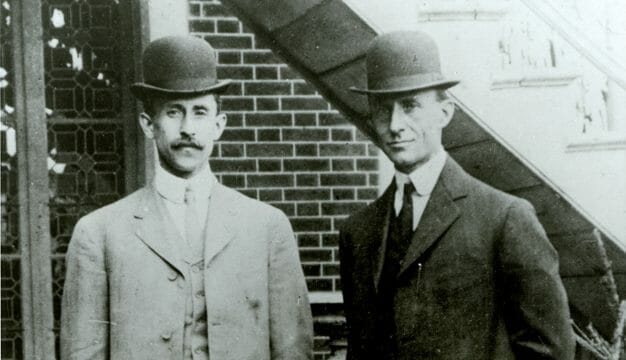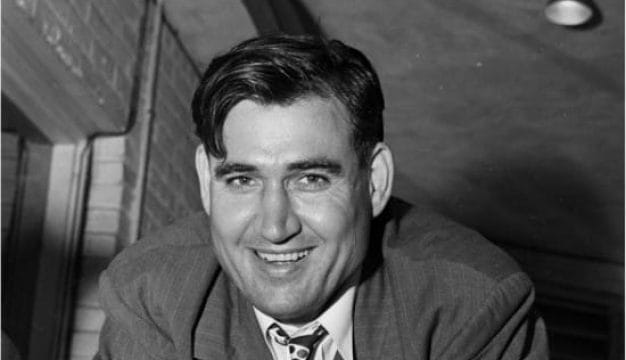Bessemer
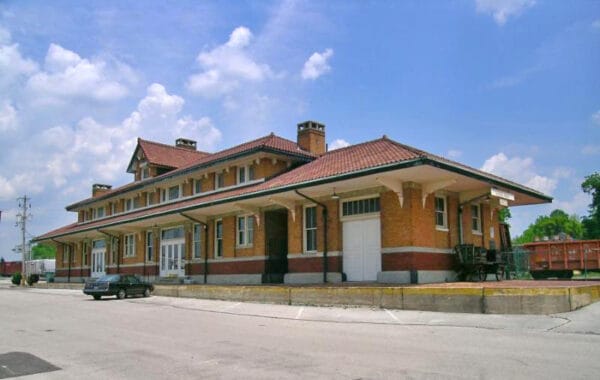 Bessemer Hall of History
Founded in 1886 by industrialist Henry Fairfield DeBardeleben, Bessemer is the third largest city in Jefferson County. It is located in central Alabama in the southern part of Jones Valley, an area rich in iron ore and limestone. Famed football and baseball star Vincent “Bo” Jackson, noted Tuskegee University photographer P. H. Polk, and actor Glenn Shadix were born in Bessemer. World-renowned artist Thornton Dial spent most of his life in the city. Residents Keith and Donna Barton gained fame in the mid-2000s for their hen, Matilda, the “World’s Oldest Living Chicken.” The city has a mayor-council form of government.
Bessemer Hall of History
Founded in 1886 by industrialist Henry Fairfield DeBardeleben, Bessemer is the third largest city in Jefferson County. It is located in central Alabama in the southern part of Jones Valley, an area rich in iron ore and limestone. Famed football and baseball star Vincent “Bo” Jackson, noted Tuskegee University photographer P. H. Polk, and actor Glenn Shadix were born in Bessemer. World-renowned artist Thornton Dial spent most of his life in the city. Residents Keith and Donna Barton gained fame in the mid-2000s for their hen, Matilda, the “World’s Oldest Living Chicken.” The city has a mayor-council form of government.
History
 Downtown Bessemer
After becoming president of the Bessemer Land and Improvement Company in 1886, Henry Fairfield DeBardeleben bought 4,000 acres of land for a planned new town that would be associated with his iron and coal businesses. He named the new city after British engineer Henry Bessemer, inventor of the most prevalent steel-making process of the time. DeBardeleben sold the first commercial lots in April 1887; by June 1887, the town had a population of about 1,000 and had established a court and jail. That same year, the citizens of Bessemer chose Robert M. McAdory as the first mayor and elected eight councilmen. The mayor and councilmen voted to incorporate the city of Bessemer on September 9, 1887. Debardeleben also purchased buildings from the 1884 Cotton Exposition in New Orleans for use in Bessemer and had them shipped to Alabama via railroad. The Mexico building became the Montezuma Hotel and served as Debardeleben’s home initially; in 1896, it became the Montezuma University Medical College, operating until it burned in 1900. The Jamaica building was used as part of a mill. Neither building still stands. Two years later, the city constructed a city hall that also housed the fire department; the building was destroyed by fire in the mid-1930s, and a new structure was built at the same location in 1937. The city also built a library with funds obtained from industrialist and philanthropist Andrew Carnegie in 1906.
Downtown Bessemer
After becoming president of the Bessemer Land and Improvement Company in 1886, Henry Fairfield DeBardeleben bought 4,000 acres of land for a planned new town that would be associated with his iron and coal businesses. He named the new city after British engineer Henry Bessemer, inventor of the most prevalent steel-making process of the time. DeBardeleben sold the first commercial lots in April 1887; by June 1887, the town had a population of about 1,000 and had established a court and jail. That same year, the citizens of Bessemer chose Robert M. McAdory as the first mayor and elected eight councilmen. The mayor and councilmen voted to incorporate the city of Bessemer on September 9, 1887. Debardeleben also purchased buildings from the 1884 Cotton Exposition in New Orleans for use in Bessemer and had them shipped to Alabama via railroad. The Mexico building became the Montezuma Hotel and served as Debardeleben’s home initially; in 1896, it became the Montezuma University Medical College, operating until it burned in 1900. The Jamaica building was used as part of a mill. Neither building still stands. Two years later, the city constructed a city hall that also housed the fire department; the building was destroyed by fire in the mid-1930s, and a new structure was built at the same location in 1937. The city also built a library with funds obtained from industrialist and philanthropist Andrew Carnegie in 1906.
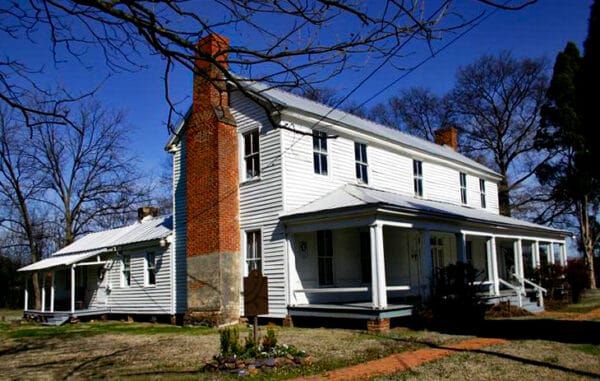 Owen House
Bessemer’s early economy centered primarily on mining and steel manufacturing, which attracted many laborers to the city, but the city’s economy often suffered during economic downturns because of resultant high unemployment in the labor sector. During a recession in 1907, the Tennessee Coal, Iron, and Railroad Company, a major employer in the city, sold stock to United States Steel to relieve debt. U.S. Steel aided Bessemer by establishing a welfare program for sick and injured employees, improving infrastructure, and investing in education for children. To supplement Jefferson County’s main courthouse in Birmingham, the county constructed a satellite courthouse in Bessemer in 1915 to serve the needs of the Bessemer area. In 1926, Pauline Fletcher, Alabama’s first Black registered nurse, established Camp Margaret Murray Washington on 30 acres of land in Bessemer as a retreat for Black women and children to experience nature. It was renamed Camp Fletcher in 1942.
Owen House
Bessemer’s early economy centered primarily on mining and steel manufacturing, which attracted many laborers to the city, but the city’s economy often suffered during economic downturns because of resultant high unemployment in the labor sector. During a recession in 1907, the Tennessee Coal, Iron, and Railroad Company, a major employer in the city, sold stock to United States Steel to relieve debt. U.S. Steel aided Bessemer by establishing a welfare program for sick and injured employees, improving infrastructure, and investing in education for children. To supplement Jefferson County’s main courthouse in Birmingham, the county constructed a satellite courthouse in Bessemer in 1915 to serve the needs of the Bessemer area. In 1926, Pauline Fletcher, Alabama’s first Black registered nurse, established Camp Margaret Murray Washington on 30 acres of land in Bessemer as a retreat for Black women and children to experience nature. It was renamed Camp Fletcher in 1942.
The county built a new courthouse in October 2009. After the decline of the mining and steel industry during the last two decades of the twentieth century, the city diversified its economy to include industrial parks, professional offices, retail centers, and recreational facilities.
Demographics
According to 2020 Census estimates, Bessemer’s population was 26,063. Of that total, 72.7 percent of respondents identified themselves as African American, 22.1 percent as white, 4.3 percent as Hispanic, 2.1 percent as two or more races, 0.2 percent as American Indian, and 0.2 percent as Asian. The city’s median household income was $30,284, and the per capita income was $20,816.
Employment
According to 2020 Census estimates, the workforce in Bessemer was divided among the following industrial categories:
- Educational services, and health care and social assistance (22.9 percent)
- Retail trade (15.7 percent)
- Manufacturing (11.9 percent)
- Finance, insurance, and real estate, rental, and leasing (11.5 percent)
- Arts, entertainment, recreation, and accommodation and food services (9.8 percent)
- Transportation and warehousing and utilities (6.5 percent)
- Professional, scientific, management, and administrative and waste management services (5.9 percent)
- Public administration (4.7 percent)
- Construction (4.2 percent)
- Other services, except public administration (3.7 percent)
- Wholesale trade (1.6 percent)
- Agriculture, forestry, fishing and hunting, and extractive (0.9 percent)
- Information (0.8 percent)
Education
Bessemer schools are administered by the Bessemer City Schools. The city has five elementary schools, one middle school, one high school, one alternative school, and a center for technology.
Transportation
Bessemer is served by U.S. Highway 11, which runs southwest-northeast through the city, and State Highway 150, which runs east from the city. It is located near Interstate Highways 65, 59, and 20. General aviation is served by the Bessemer Airport.
Events and Places of Interest
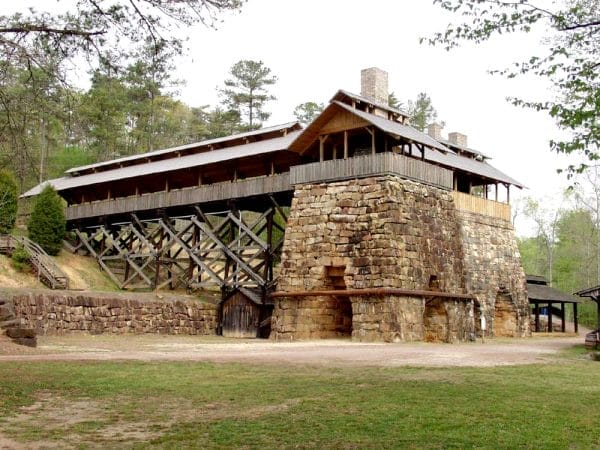 Historic Furnaces at Tannehill
Attractions in Bessemer include Alabama Adventure theme park, which features a traditional amusement park with rides and a water park; WaterMark Place Outlet Shopping Center; and a city-owned civic center that hosts live theater, sporting events, concerts, banquets, and expositions. Bessemer is also home to Tannehill Ironworks Historical State Park, located on the site of a historic foundry that operated from 1829 to 1865 and served the Confederacy during the Civil War; this site also is home to the Iron and Steel Museum. Other historic sites include the McAdory Plantation House and the Owen Plantation House, two of the three homes that comprise the nineteenth-century West Jefferson County Pioneer Homes. The century-old Bright Star, a five-star restaurant named an American classic by the James Beard Foundation, is located in downtown Bessemer. The Bessemer Hall of History Museum contains artifacts and displays related to Bessemer’s industrial and cultural history; it is housed in the former Alabama Great Southern Railroad Depot and is on the National Register of Historic Places. Watercress Darter National Wildlife Refuge is located just outside of Bessemer and protects the habitat of the endangered watercress darter, a small freshwater fish.
Historic Furnaces at Tannehill
Attractions in Bessemer include Alabama Adventure theme park, which features a traditional amusement park with rides and a water park; WaterMark Place Outlet Shopping Center; and a city-owned civic center that hosts live theater, sporting events, concerts, banquets, and expositions. Bessemer is also home to Tannehill Ironworks Historical State Park, located on the site of a historic foundry that operated from 1829 to 1865 and served the Confederacy during the Civil War; this site also is home to the Iron and Steel Museum. Other historic sites include the McAdory Plantation House and the Owen Plantation House, two of the three homes that comprise the nineteenth-century West Jefferson County Pioneer Homes. The century-old Bright Star, a five-star restaurant named an American classic by the James Beard Foundation, is located in downtown Bessemer. The Bessemer Hall of History Museum contains artifacts and displays related to Bessemer’s industrial and cultural history; it is housed in the former Alabama Great Southern Railroad Depot and is on the National Register of Historic Places. Watercress Darter National Wildlife Refuge is located just outside of Bessemer and protects the habitat of the endangered watercress darter, a small freshwater fish.
Further Reading
- Badham, Jr., H. L., comp. History of the Bessemer Coal, Iron, and Land Company. Bessemer: N.p., 1948.
